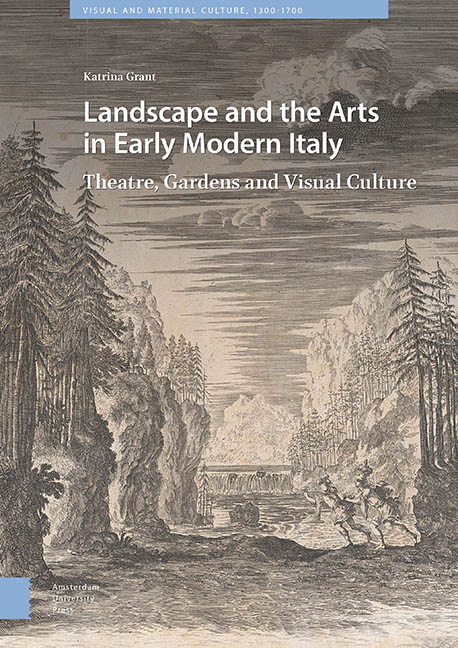Book contents
- Frontmatter
- Contents
- Acknowledgements
- Introduction
- 1 Theatricality, a View from the Landscape
- 2 Gardens of the Gods : Classical Revival, Intermedi, Early Opera and the Idea of Nature
- 3 The (Singing) Figure in the Landscape
- 4 Triumph over Nature : Machines and Meraviglia on the Seventeenthcentury Stage
- 5 The Theatre in the Landscape : Pliny to Pratolino
- 6 The Garden as Stage, the Visitor as Performer
- 7 Stages without Actors : Theatres of Sculpture, Water and Flowers
- 8 Performing in the Parrhasian Grove : Green Theatres and the Academies
- Bibliography
- Index
5 - The Theatre in the Landscape : Pliny to Pratolino
Published online by Cambridge University Press: 15 September 2022
- Frontmatter
- Contents
- Acknowledgements
- Introduction
- 1 Theatricality, a View from the Landscape
- 2 Gardens of the Gods : Classical Revival, Intermedi, Early Opera and the Idea of Nature
- 3 The (Singing) Figure in the Landscape
- 4 Triumph over Nature : Machines and Meraviglia on the Seventeenthcentury Stage
- 5 The Theatre in the Landscape : Pliny to Pratolino
- 6 The Garden as Stage, the Visitor as Performer
- 7 Stages without Actors : Theatres of Sculpture, Water and Flowers
- 8 Performing in the Parrhasian Grove : Green Theatres and the Academies
- Bibliography
- Index
Summary
Abstract
The second half of this book examines theatre in the landscape. This chapter begins by looking at how the idea of the landscape as theatre developed in the sixteenth century, with architects like Palladio, and others, picking up the Plinian idea of the landscape as a vast amphitheatre. It then explores the rise of the emergence of the garden as a theatre in the sixteenth century and its connection to ancient sources, contemporary theatre and pastoral literature. Gardens discussed include the Villa Madama in Rome and the Sacro Bosco at Bomarzo.
Keywords: Gardens, Designed Landscapes, Renaissance, Garden Theatres, Antique Revival
What is a garden theatre? The terms ‘theatre’, teatro or théâtre appear on many illustrations of gardens and in written accounts labelling features ranging from fountains to courtyards. The exact function of these spaces is sometimes obvious: the amphitheatre at the Boboli gardens, for instance, was constructed as a performance space for large scale festivities. Water theatres, although not used for performance in the conventional sense, were stages for dramatic displays of hydraulic engineering, as at the garden of the Villa Aldobrandini at Frascati. But in other instances, the exact theatrical function is elusive. This leads us to the question: what was the label ‘theatre’ intended to identify to the visitor at the time? Was it a term applied systematically to denote a certain type of structure or space? Or was it a term applied in a more random fashion to suggest a certain ‘theatricality’ or ‘scenographic sensibility’ in the way that visitors in the seventeenth century approached the experience garden. Neither of these questions can be properly answered without an understanding of the origins of the garden theatre in Italian gardens in the late fifteenth century.
Antique Sources
There is no precise origin for the introduction of theatrical structures into the Italian garden. They became more common from the early seventeenth century, but they clearly have a precedent in several structures designed for Italian gardens in the fifteenth and sixteenth centuries. These theatre designs tended to draw on antique sources and were often built to emulate the ancients. The sources of these theatres tended to be extant remains of Roman theatres (both public and private examples) and references made to theatres in antique literature.
- Type
- Chapter
- Information
- Landscape and the Arts in Early Modern ItalyTheatre, Gardens and Visual Culture, pp. 145 - 174Publisher: Amsterdam University PressPrint publication year: 2022

